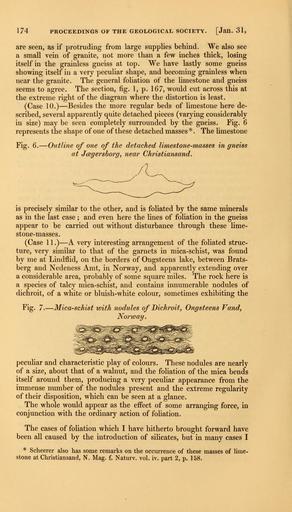MAKE A MEME
View Large Image

| View Original: | The_Quarterly_journal_of_the_Geological_Society_of_London_(12711593913).jpg (1828x3200) | |||
| Download: | Original | Medium | Small | Thumb |
| Courtesy of: | commons.wikimedia.org | More Like This | ||
| Keywords: The Quarterly journal of the Geological Society of London (12711593913).jpg 174 PROCEEDINGS OF THE GEOLOGICAL SOCIETY Jan 31 <br> are seen as if protruding from large supplies behind We also see <br> a small vein of granite not more than a few inches thick losing <br> itself in the grainless gneiss at top We have lastly some gneiss <br> showing itself in a very peculiar shape and becoming grainless when <br> near the granite The general foliation of the limestone and gneiss <br> seems to agree The section fig 1 p 167 would cut across this at <br> the extreme right of the diagram where the distortion is least <br> Case 10 Besides the more regular beds of limestone here de- <br> scribed several apparently quite detached pieces varying considerably <br> in size may be seen completely surrounded by the gneiss Fig 6 <br> represents the shape of one of these detached masses The limestone <br> Fig 6 Outline of one of the detached limestone-masses in gneiss <br> at Jcegersborg near Christiansand <br> is precisely similar to the other and is foliated by the same minerals <br> as in the last case ; and even here the lines of foliation in the gneiss <br> appear to be carried out without disturbance through these lime- <br> stone-masses <br> Case 1 1 A very interesting arrangement of the foliated struc- <br> ture very similar to that of the garnets in mica-schist was found <br> by me at Lindflid on the borders of Ongsteens lake between Brats- <br> berg and Nedeness Amt in Norway and apparently extending over <br> a considerable area probably of some square miles The rock here is <br> a species of talcy mica-schist and contains innumerable nodules of <br> dichroit of a white or bluish-white colour sometimes exhibiting the <br> Fig 7 Mica-schist with nodules of Dichroit Ongsteens Vand <br> Norway <br> pecuHar and characteristic play of colours These nodules are nearly <br> of a size about that of a walnut and the foliation of the mica bends <br> itself around them producing a very peculiar appearance from the <br> immense number of the nodules present and the extreme regularity <br> of their disposition which can be seen at a glance <br> The whole would appear as the effect of some arranging force in <br> conjunction with the ordinary action of foliation <br> The cases of foliation which I have hitherto brought forward have <br> been all caused by the introduction of silicates but in many cases I <br> Scheerer also has some remarks on the occurrence of these masses of lime- <br> stone at Christiansand N Mag f Naturv vol iv part 2 p 158 35614746 110213 51125 Page 174 Text v 11 http //www biodiversitylibrary org/page/35614746 1855 Geological Society of London Biodiversity Heritage Library The Quarterly journal of the Geological Society of London v 11 1855 Geology Periodicals Smithsonian Libraries bhl page 35614746 dc identifier http //biodiversitylibrary org/page/35614746 smithsonian libraries Information field Flickr posted date ISOdate 2014-02-23 Check categories 2015 August 26 CC-BY-2 0 BioDivLibrary https //flickr com/photos/61021753 N02/12711593913 2015-08-26 21 00 10 cc-by-2 0 PD-old-70-1923 The Quarterly journal of the Geological Society of London 1855 Photos uploaded from Flickr by FĂŚ using a script | ||||